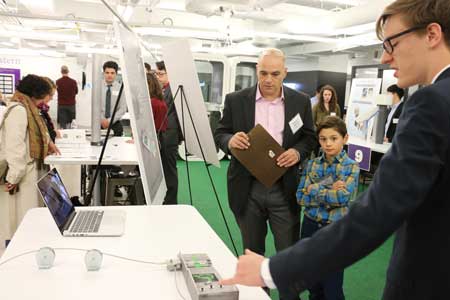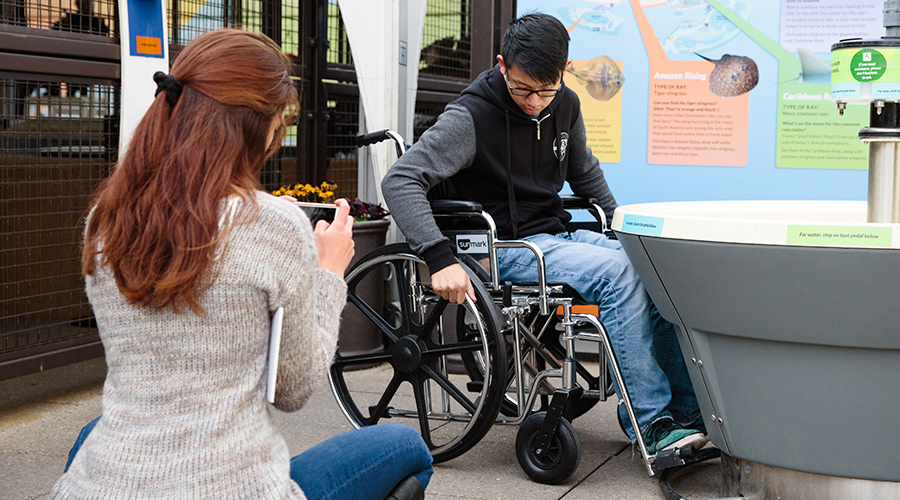Roll N WashA foot pedal to be activated by a wheelchair to turn on sinks at the Shedd Aquarium
Design Thinking and Communication (DTC), is a required two-quarter course for all first-year students at Northwestern Engineering. Part of the Engineering First® curriculum, the course immediately puts students to work on real design problems submitted by individuals, non-profits, entrepreneurs, and industry members. Students learn that both design and communication are iterative, context-centered, problem-solving processes. The course is co-taught by an instructor from Northwestern Engineering and by an instructor from the Cook Family Writing Program at the Weinberg College of Arts and Sciences.
For their client, Shedd Aquarium in Chicago, a team of four first-year students tried to tackle the problem of accessibility for public sinks. Kristen Neria, Assistant Director of Exhibit Services at the Shedd Aquarium, explained the challenge facing them.
The Problem
“We currently have portable hand washing stations outside our Stingray Touch exhibit. These are operated by a push bar below and are not designed to be used by a person in a wheelchair,” Neria said. “It has been difficult to find any manufacturer with a model that can be used outdoors with a temporary water source that is accessible to all guests. The users would be guests or staff who use wheelchairs.”
Jack Eichenlaub, a first-year student majoring in Mechanical Engineering, Andrew Parsons, a first-year student majoring in Computer Science, Ian Stokes, a first-year student majoring in Mechanical Engineering, and Matthew Marchione, a first-year student majoring in Industrial Engineering, comprised the team. Together, they designed the Roll N Wash.I knew I would learn about human-centered design here, but I didn’t think I would be this happy to have learned about it.
I knew I would learn about human-centered design here, but I didn’t think I would be this happy to have learned about it.
The Solution
“Roll N Wash is a foot pedal to be activated by a wheelchair to turn on sinks at the Shedd Aquarium that are currently inaccessible to people in wheelchairs,” explained Eichenlaub.
An integral step in the design process is user-observation so the team went to the Shedd Aquarium to observe users and learn more about the problem.
“When you approach a sink head-on, as most people do approach a sink, you could not turn on the water, you could not access the water as it flowed out of the sink, nor could you reach the soap. Three strikes you’re out,” explained Eichenlaub. “However, we saw from users there and our own personal attempts where we borrowed the Shedd Aquarium’s wheelchair, that when we approached sideways tangent to the circular sink, we could reach the soap and could reach the water. However, we still couldn’t turn on the water. So, with that in mind, we decided that the number one problem was turning on the water.”
The Process
Once the team decided on their number one problem, they got to work creating prototypes back at the Segal Prototyping and Fabrication Lab. The hardest part of the prototyping process was working with stainless steel, agreed Stokes and Eichenlaub. The team encountered challenges while working with that particular material and had to incorporate those lessons into their learning experience.
“I was in charge of ordering materials and I ordered multipurpose stainless steel. However, it turns out the steel I ordered is one of the hardest stainless steels,” explained Eichenlaub. “When you attempt to cut it and drill through it, if you go too slow or with too dull of a tool, it will heat treat itself and become extremely difficult to cut. Our design on paper was not too difficult, but manufacturing it in the shop was a challenge.”
Fortunately, the team had the support and expertise of staff and faculty during the prototyping phase of the project, including Joe Kuechel, Scott Simpson, and Heidi Huckabay.
“And, of course all the shop trainers were super helpful, too," said Eichenlaub. "We probably had fifteen different people help us over the course of the project.”
One of the team's faculty advisors, Emma DeCosta, praised their attitude and persistance.
“Jack, Ian, Matthew, and Andrew were a great team, whose positive, can do attitude and true desire to help people in wheelchairs fully experience the Stingray Touch exhibit was clear from the first day of class. They seemed undaunted by the initial problems with their mock-ups and designs, and they kept working on the prototypeup until they delivered, even going down to do final performance tests during exam week.”>

While everyone on the team was new to the concept of human-centered design, they quickly absorbed the fundamentals of it.
“I’ve always been a big fan of things that make sense to use,” said Eichenlaub. “We heard lectures through the DTC program on Monday nights. One was from people in industry who work with human-centered design talking about the things they made, like Swiffers and stuff. I thought, ‘This makes so much sense!’ I knew I would learn about human-centered design here, but I didn’t think I would be this happy to have learned about it.”
“We’ve talked to some older students and heard about their experience in DTC and a couple of them have chosen to be MaDE majors. That’s something that as a mechanical engineer myself that I have become interested in through this DTC process," said Marchione.
Parsons said the best part about his DTC experience was team-bonding. “We all bonded really quick. We’re definitely very close friends at this point so that helped with workflow and stuff like that,” said Parsons. “The whole class was incredible.”
Terry Breen, the team's faculty advisor from the Cook Family Writing Program, praised their communications skills.
"Besides excelling in their design tasks, the team excelled in both written and oral communication assignments," he said. "They even won a communication award at the DTC Project Fair."
ProgramsDesign Thinking and Communication (DTC)
Faculty AdvisersEmma DeCosta, Terry Breen



